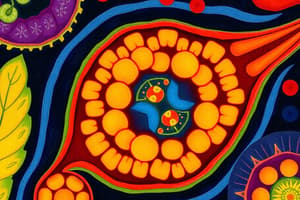Podcast
Questions and Answers
How do the structural differences between xylem and phloem contribute to their distinct functions in a plant?
How do the structural differences between xylem and phloem contribute to their distinct functions in a plant?
Xylem's rigid structure, composed of dead cells, allows efficient water transport from roots to leaves, while phloem's living cells with sieve plates facilitate the bidirectional movement of food (sugar) throughout the plant.
Explain how the arrangement of vascular tissue in stems, roots, and leaves contributes to the overall transport efficiency in plants.
Explain how the arrangement of vascular tissue in stems, roots, and leaves contributes to the overall transport efficiency in plants.
The continuous network of vascular tissue (xylem and phloem) from roots, through stems, and into leaves ensures efficient water and nutrient transport throughout the plant. The specific arrangement in each organ optimizes its function, such as centralized vascular bundles in roots for absorption and branching veins in leaves for photosynthesis.
Compare and contrast the functions of parenchyma and sclerenchyma cells in plants, highlighting their roles in support and storage.
Compare and contrast the functions of parenchyma and sclerenchyma cells in plants, highlighting their roles in support and storage.
Parenchyma cells primarily function in storage of food and water and photosynthesis, while sclerenchyma cells provide support and transport materials in some cases. Sclerenchyma cells are dead at maturity, providing rigid support, whereas parenchyma cells are living and metabolically active.
How do the structures of stomata and trichomes contribute to a plant's ability to regulate water loss and temperature?
How do the structures of stomata and trichomes contribute to a plant's ability to regulate water loss and temperature?
Describe how the features of fibrous and taproot systems are related to their roles in water absorption and plant stability.
Describe how the features of fibrous and taproot systems are related to their roles in water absorption and plant stability.
Explain the relationship between meristematic tissue and plant growth, and where this tissue can be found in the plant.
Explain the relationship between meristematic tissue and plant growth, and where this tissue can be found in the plant.
How does considering the age of a tree relate to the function of xylem?
How does considering the age of a tree relate to the function of xylem?
Explain how the storage capabilities of modified roots and stems relate to plant survival and reproduction strategies. Provide examples of each.
Explain how the storage capabilities of modified roots and stems relate to plant survival and reproduction strategies. Provide examples of each.
Flashcards
Parenchyma
Parenchyma
Plant cells that store food and water, aiding photosynthesis.
Meristematic tissue
Meristematic tissue
Tissue that helps the plant grow by creating new cells, found at root and stem tips.
Stomata
Stomata
Small openings on leaves for gas exchange, controlled by guard cells.
Xylem
Xylem
Signup and view all the flashcards
Phloem
Phloem
Signup and view all the flashcards
Roots
Roots
Signup and view all the flashcards
Taproot
Taproot
Signup and view all the flashcards
Nastic response
Nastic response
Signup and view all the flashcards
Study Notes
Plant Cell Types
- Parenchyma: Stores food and water, aids in photosynthesis.
- Collenchyma: Provides flexibility and support to the plant.
- Sclerenchyma: Provides support and transports materials; this cell type is dead.
Plant Tissues
- Meristematic Tissue: Facilitates plant growth by producing new cells; found in root and stem tips.
- Dermal Tissue: Protects the plant from water loss, pests, and diseases; covers the plant's exterior.
- Vascular Tissue: Transports water and nutrients throughout the plant; located in stems, roots, and leaves.
- Ground Tissue: Stores nutrients and provides support; found wherever vascular and dermal tissues are not.
Plant Structures
- Stomata: Small openings on leaves and stems, enabling gas exchange (CO2 in, O2 out); controlled by guard cells.
- Trichomes: Protect the plant (reduce water loss, control temperature, fight germs, absorb water).
- Root Hairs: Increase the surface area for water and nutrient absorption.
Xylem and Phloem Structure Comparison
- Xylem: Transports water and nutrients from roots to leaves.
- Phloem: Transports food (sugar) from leaves to other plant parts.
Roots
- Function: Anchor the plant, absorb water and nutrients.
- Taproot: Grows deep into the soil, stores food and water.
- Fibrous: Numerous small roots spreading out, providing stability and rapid water absorption.
- Modified Roots: Store food and nutrients.
- Pneumatophores: Grow above ground to supply oxygen to roots in underwater environments.
- Adventitious: Grow from stems, helping support the plant.
Stems
- Function: Transport water and food between roots and leaves.
- Tuber: Stores food.
- Rhizome: Stores food and allows asexual reproduction.
- Runner: Enables asexual reproduction.
- Bulb: Stores food underground.
- Corm: Stores food.
Leaves
- Venation: Patterns of veins in leaves (palmate, pinnate, parallel).
- Arrangement: Position of leaves on the stem (opposite, alternate, whorled).
- Simple Leaf: One undivided blade.
- Compound Leaf: Divided into leaflets.
Plant Responses
- Nastic Response: Plant movement in response to a stimulus (light, touch, temperature).
- Tropism: Plant growth toward or away from a stimulus (light, gravity, water, touch).
- Phototropism: Growth toward light.
- Gravitropism: Growth in response to gravity (positive downward, negative upward).
- Thigmotropism: Growth in response to touch.
Tree Growth/Age
- A new ring of xylem cells is formed every year, indicating the tree's age.
Studying That Suits You
Use AI to generate personalized quizzes and flashcards to suit your learning preferences.




